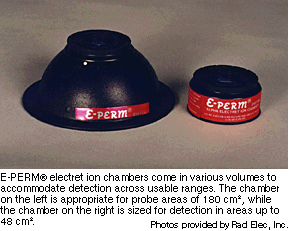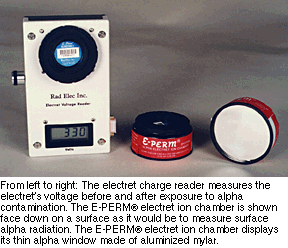Rad Elec
prepares to enter
the DOE marketplace
Electret ion chamber
senses low levels of alpha radiation
Rad Elec, Inc. of Frederick, Maryland is
positioning itself to provide passive alpha detectors for
the DOE marketplace. Global Environmental Technology
Enterprise (see related article)
and Rad Elec have jointly prepared a deployment plan for
the company's E-PERM®
electret ion chamber. The deployment plan defines the DOE
market for this technology in terms of anticipated DOE
expenditures on site and equipment
characterization—$250 to $300 million annually. The
plan also estimates that more than 50 percent of DOE
sites have a need to quickly and cheaply survey surfaces,
soils, debris, and pipes for uranium and plutonium-alpha
emitters that are particularly difficult to characterize
due to their short range. Performance data contained in
the plan were collected during limited demonstrations at Oak Ridge National Laboratory,
the Nevada Test Site, Rocky Flats, Fernald, and the
Tonopah Test Range.
How it works
 When
ionizing alpha radiation from a contaminated surface
enters an electret ion chamber through a thin aluminized
mylar window, the radiation causes ionization by
stripping electrons from atoms of air in the chamber. The
ejected electrons are attracted to a positively charged
piece of Teflon called the electret inside the E-PERM® ion chamber. The electrons
collect on the surface of the electret and over time
neutralize its charge. After the designated exposure time
has elapsed, a technician removes the electret from the
chamber. Using a portable, lightweight charge reader, the
technician measures the electret's final voltage. The
difference in the electret's initial and final voltages
is a function of the exposure time and the alpha
contamination level to which the chamber has been
exposed. After the charge reader measures the change in
the electret's voltage, this data can be analyzed with a
handheld computer or sent to a PC for calculation of the
contamination level. When
ionizing alpha radiation from a contaminated surface
enters an electret ion chamber through a thin aluminized
mylar window, the radiation causes ionization by
stripping electrons from atoms of air in the chamber. The
ejected electrons are attracted to a positively charged
piece of Teflon called the electret inside the E-PERM® ion chamber. The electrons
collect on the surface of the electret and over time
neutralize its charge. After the designated exposure time
has elapsed, a technician removes the electret from the
chamber. Using a portable, lightweight charge reader, the
technician measures the electret's final voltage. The
difference in the electret's initial and final voltages
is a function of the exposure time and the alpha
contamination level to which the chamber has been
exposed. After the charge reader measures the change in
the electret's voltage, this data can be analyzed with a
handheld computer or sent to a PC for calculation of the
contamination level.
The small, rugged, lightweight E-PERM®
electret ion chambers are passive sensors—they need
neither power nor batteries. They can be affixed on
contaminated walls, ceilings, floors, or equipment and
left in place for two to four hours to measure levels as
low as free-release limits—1 to 2 disintegrations
per minute (dpm) per cm2.
They are efficient at detecting alpha radiation and,
therefore, suitable for monitoring contamination from
uranium, plutonium, and other alpha emitters. A
corresponding unit with a window that stops alpha
radiation provides background measurement for calculating
net alpha radiation.
Several hundred of these detectors can be deployed
simultaneously. A technician simply places them at
specific test locations and collects them at the end of
the desired exposure time, thereby minimizing the time
the surveyor is present in the contaminated area.
Benefits
 S. K.
Dua from Florida International University spoke about the
technology at the characterization,
monitoring, and sensor technology Crosscutting
Program annual review of projects, held in Gaithersburg,
Maryland in April 1998. He concluded that the method is
suitable for large-scale survey at a cost of less than $5
per measurement. S. K.
Dua from Florida International University spoke about the
technology at the characterization,
monitoring, and sensor technology Crosscutting
Program annual review of projects, held in Gaithersburg,
Maryland in April 1998. He concluded that the method is
suitable for large-scale survey at a cost of less than $5
per measurement.
The baseline method of measuring for alpha
contamination is technicians moving alpha-counting survey
meters over a surface to scan for radiation. These survey
meters and their accessories cost $2,000 to $3,000 each,
are relatively heavy but delicate, can become light
sensitive, and require skilled technicians. They are
difficult to use on large surface areas, such as floors,
walls, and ceilings, and in difficult-to-reach places.
The handheld meters also require technicians to spend
more time in contaminated areas.
The electret ion chamber technology overcomes some of
these limitations and is less expensive than
alpha-counting survey meters. One charge reader, at a
cost of $2,000 to $4,000 depending upon features, can be
used with hundreds of reusable chambers, which cost about
$40 each. Electrets for insertion inside the reusable
chambers cost about $1 per measurement. Factoring in the
cost of technicians brings the per-measurement cost to
less than $5.
Full-range alpha
characterization
The E-PERM®
electret ion chamber technology can be configured to
provide various sensitivities and useful ranges. Various
electret thicknesses are available: 1.524 mm
(short-term), 0.127 mm (long-term), and specially
prepared 4.572 mm. Different chamber volumes can be
selected to accommodate probe areas ranging from 50 cm2 to 180 cm2.
Another factor in deploying this technology is selecting
the exposure time to correspond with the radiation level
and the level of accuracy desired.
An OST-sponsored
technology
The E-PERM®
electret ion chamber technology has benefited from the
support of DOE's Office
of Science and Technology. A cooperative agreement
between Rad Elec and Oak Ridge National Laboratory for
fiscal years 1994 through 1996 built upon Rad Elec's
promising idea of using electrets inside chambers for
detecting alpha contamination. Subsequent support through
the Federal Energy
Technology Center's Industry Programs has helped the
technology ready itself for entry into the DOE
marketplace. Current issues relate to tailoring the
technology for full-scale deployment at a specific DOE
site, configuring electret ion chambers for specific
alpha sources, and completing protocols for using the
E-PERM® System in
decommissioning and decontamination operations. Rad Elec
manufactures the patented sensors and associated
instrumentation.
Rad Elec has had commercial success with a similar
technology using the same electret ion chambers as
sensors—its E-PERM®
radon monitor. The U.S. Postal Service purchased 20,000
of the company's radon monitors over a three-year period
for checking radon levels in its 36,000 post office
buildings. The E-PERM®
radon monitor has a 20 percent market share for indoor
radon detectors in the United States and is widely used
in Europe and South Africa.
To receive a brochure on Rad Elec's E-PERM® System, select
it on the Reader Service Card.
For more information on this technology, call President
Paul Kotrappa at (301) 694-0011, or e-mail him at PKotrappa@aol.com.
|

